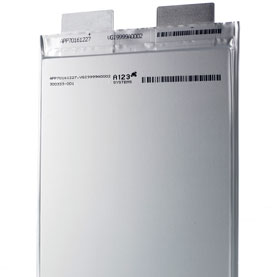 |
| BETTER CELLS: A new battery from A123 Systems delivers more power, remains easy to manufacture and can operate from -30 degrees Celsius to 60 degrees C--a far broader range than any other lithium ion cell. Image: Courtesy of A123 Systems |
A new lithium ion battery technology may finally make the devices cheap enough and durable enough to turn electric cars from a niche product into a mass-market mode of transport. Waltham, Mass.-manufacturer A123 Systems has produced a cell that delivers 20 percent more power, works at temperatures as low as –30 degrees Celsius and as high as 60 degrees C, and should be just as easy as current batteries to manufacture.
"There's no 'unobtainium' in this battery," says company co-founder, Massachusetts Institute of Technology materials scientist Yet-Ming Chiang. "It's not based on a very expensive new chemistry."
Independent scientists have been scrutinizing the company's claims and say they are impressed. From the few details the company will reveal, the new battery, known as the Nanophosphate EXT, appears to be based on the exact same lithium-iron phosphate chemistry found in other A123 batteries that appear everywhere from electronics to hybrid electric buses, but with improved properties.
The improved power and expanded temperature range suggest that A123 scientists have improved the way that electrons and ions shuffle through the battery system. "The ions and electrons have to move faster," explains chemist Jeffrey Chamberlain, who leads the Energy Storage Initiative at Argonne National Laboratory and was not involved in this research. That, in turn, suggests an improvement in one of three places: the electrolyte (the ion-carrying guts of the battery); the interface between the electrolyte and the electrodes (the charge-collecting plates); the electrodes themselves; or all of the above. Manufacturing innovations may also contribute. Although the specifics of the Nanophosphate EXT improvements remain unclear, A123 does hold patents relating to work on novel electrode and electrolyte materials as well as battery structures. "If this is real, it's a major breakthrough," Chamberlain adds.
A123's internal results have been independently verified by the Center for Automotive Research at The Ohio State University. "We perceive only positive characteristics for this remarkable technology," says O.S.U. mechanical engineer Yann Guezennec, who led testing of the new cell. Those characteristics include charge/discharge cycle-lives at least twice as long as a competitor "currently in use in a vehicle that is on the road today," says A123 spokesman Dan Borgasano, and 10 times longer than existing lead–acid batteries.
One downside is that A123's iron phosphate technology only offers roughly 160 watt-hours per kilogram, an energy density less than some other lithium ion technologies (not to mention liquid fuels like gasoline). On the plus side, it is not prone to bursting into flame, as some lithium cells are. "One big benefit of iron phosphate is its stability and safety," Chamberlain says. "Things you find in nature when you dig up dirt tend to be pretty stable."
And the battery's long life may outweigh any lack in the energy-density department; it retains 90 percent of its capacity even after 2,000 chargings and dischargings. The batteries in current electric cars, on the other hand, fade over time, requiring car manufacturers to include batteries that are bigger than necessary. Plus, A123's new battery can be air-cooled rather than liquid-cooled, thanks to its wide temperature range, offering savings in both cost and weight.
That said, A123's new batteries may first find use in automobiles not in all-electric cars but in micro-hybrids, which automatically shut down at a red light and start up again when the light turns green to save fuel, powered by batteries recharged by braking. Current lead–acid batteries can do the job, but would need to be replaced every few years whereas A123's new lithium ion batteries might last as long as the car. A123's batteries are slightly more expensive (roughly $250 more per battery), but also half as heavy and 30 percent smaller. According to Borgasano, an unnamed German automaker has already committed to using the batteries in a forthcoming micro-hybrid, to be manufactured in 2013, and A123 Systems also hopes to compete as a starter battery for traditional automobiles.
Cars are not the only application, however. The 20 ampere-hour cells soon to be churned out of A123's Michigan manufacturing facilities may provide battery backup power for the electric grid or run cell phone towers, on account of their long-life, small size and lack of a need for active cooling systems. The company plans to begin selling the cells in 2013.
First the firm will have to survive, as its financial reports reveal a company spending its cash reserves and reporting large losses, in part due to woes at the electric carmaker Fisker, which employs A123 technology. Those woes have been compounded by the fact that A123 had to recall defective cells used in the Fisker Karma and manufactured in its Livonia, Mich., facility. "The proof is in the pudding," Chamberlain says. "I hope this is real and I hope they start selling cells in the spring."


